When visiting the Inn, and travelling through the Hall, Bench Apartments and the Ashley Building, one can see walls adorned with paintings. In doing so, one can observe a prevalence of male representation, in sitters and artists. Within the Inn's collection of portraits, there are three paintings of royal female sitters, and three of non-royal female sitters: Master Dawn Oliver (2018), Master Patricia Scotland (2021) and Master Kate Thirlwall (2021); six of the portraits in the collection are painted by five different female artists. This month we will take a closer look at the representation of women in paintings around the Inn and discover more about the five female artists whose paintings are displayed in Middle Temple.
Female Representations in Paintings
As, for much of the Inn's history, women were barred from admission as members, there are few individual portraits of female sitters. However, a number of paintings around the Inn feature female characters. The earliest artistic representation of women in paintings at the Middle Temple is in the ‘Judgement of Solomon’, c.1600, which currently hangs in the Parliament Chamber. The painting depicts the biblical story of King Solomon who poses a question to two women claiming to be the mother of a baby in order to determine the real mother. While these two women are represented in the painting, they are portrayed in a negative style, perhaps intended to resemble prostitutes. This compares unfavourably to the depiction of King Solomon, the central, enthroned figure.
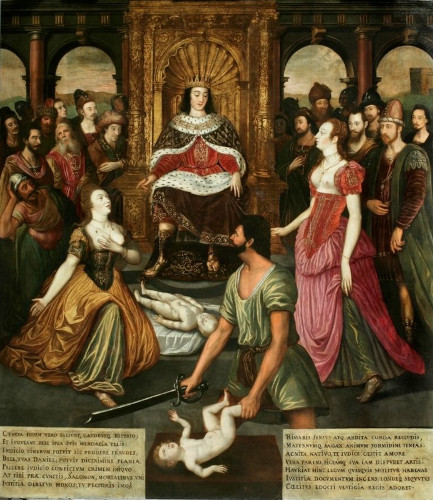
The Judgement of Solomon.
Another piece of artwork on display at the Inn which depicts women is the 1738 painting ‘The Fountain at the Temple’ by Joseph Nickolls which currently hangs in the Prince’s Room. In this painting, several women feature as background characters; one can see on the periphery a woman accepting a delivery of game and another woman with her family stood overlooking the Middle Temple Gardens. Having been painted during an era when women were barred from joining the Inn or renting chambers in their own right, this painting represents women in the roles, as wives or maids, which they would have occupied at the time.
The Fountain at Temple by Joseph Nickolls.
Royal Female Sitters
Prior to 2018, when a portrait of Master Dawn Oliver was commissioned, the only portraits at the Inn showing female sitters were those depicting Royal women. These three women are Queen Elizabeth I, Queen Anne, and the Queen Mother, of whom there are two portraits in the collection.
The largest of these is a full-length portrait of Queen Anne in her coronation robes, which hangs in Hall. The portrait was commissioned by the Inn’s Parliament shortly after Queen Anne’s accession to the throne, and was originally intended to be painted by Michael Dahl; it was eventually painted by Thomas Murray. The Inn’s Parliament stated that: “it is referred to Mr. Treasurer to set up the Queen's picture at the west end of the Hall over the Bench table; and to have it drawn by Mr. Dalle unless he thinks fit to make use of another hand.” The receipt for the artwork is dated 9 November 1703 and states a cost of £53 15s “for drawing her Majesties picture at full length.”
Queen Anne by Thomas Murray.
Near Queen Anne on the wall in Hall sits a three-quarter length standing portrait of Queen Elizabeth I, which may date from the 18th or 19th century, which was purchased by the Inn in an attempt to remedy the lack of a portrait of a Queen so closely associated with the building of Middle Temple Hall. Queen Elizabeth herself famously came to the Middle Temple Hall on completion of its construction under the oversight of the Inn's Treasurer, Edmund Plowden, who was a favourite of hers; the High Table is supposedly made from an oak floated down from Windsor at the behest of the Queen herself. It is unknown who the portrait is by, but it was purchased by the Inn from a J. Flack for £11 on 15 August 1879.
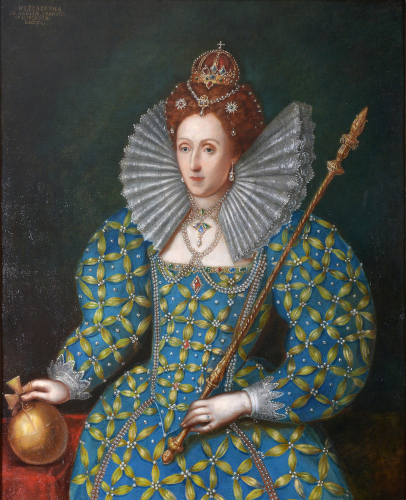
Queen Elizabeth I.
The Inn also possesses two paintings of the Elizabeth Bowes-Lyon, the Queen Mother who was very closely associated with the Inn, having been made a Royal Bencher in 1944, thus becoming the first woman Bencher of Middle Temple.' She served as Treasurer in 1949, and attended a great number of the events at the Inn over the next half century, from Grand Days to Family Dinners, and had an excellent relationship with the Inn's Benchers. The first is a three-quarter length seated portrait of The Queen Mother in the gown of a Master of the Bench which was commissioned by the Inn in 1946 to celebrate their Royal Bencher. The second was commissioned by Alan King-Hamilton, a past member of Middle Temple, and presented to the Inn in 1980 showing her standing in the garden with Hall in the background.
Two portraits of the Queen Mother which hang at Middle Temple.
Female-created artwork and paintings of women at the Inn
While most of the painters whose work hangs on the walls of the Inn are male, there is a growing number of female-created artwork. These paintings include the three portraits of non-Royal women in the collection. The collection currently includes six paintings by five different female artists.
The eldest of these is a portrait of Francis Roxburgh which was painted by Hariette Sutcliffe in 1887. The painting was presented to the Inn in 1965 by Ronald Roxburgh, grandson of Francis Roxburgh, and later was on loan to the Council of Legal Education and to the Oxford Crown Court. Sutcliffe was a London painter who lived in Hampstead, between 1881 and 1899 she exhibited several pictures at the Royal Academy including “A Posy for you, Sweetheart” in 1892.
Francis Roxburgh by Hariette Sutcliffe.
Another painting by a woman is of William Finlay, 2nd Viscount Finlay of Nairn, c.1920 which was created by the artist Charlotte Blakeney Ward. Ward, who was from Manchester, had previously exhibited paintings at the Royal Academy, St Ives Society of Arts and, in 1900, at the Paris Salon, an exhibition considered to be the greatest art event in the Western world for much of its history. Ward was a member of the Society of Women Artists, becoming Vice President from 1917 and held its Presidency from 1923-1931. Some of her other portrait subjects included suffragist Mary Collin and the poet Robinson Jeffers.
William Finlay by Charlotte Blakeney Ward.
Isobel Macleod is another female artist whose work hangs in the Middle Temple. Macleod painted a seated portrait of Alexander Martin Sullivan, c.1958, the last person created King’s Serjeant in Ireland in 1920. The painting is oil on canvas and was purchased by the Inn directly from Macleod in October 1958. Sadly, little information is known about Isobel Macleod and her work.
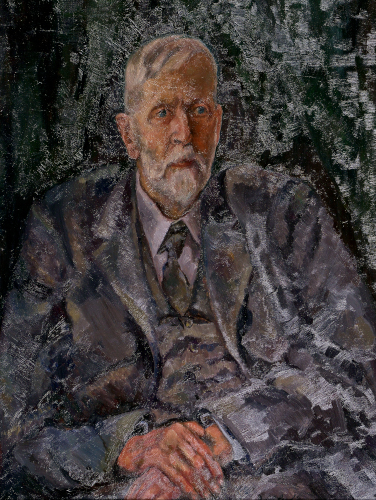
Alexander Martin Sullivan by Isobel Macleod.
In 2018, the first of three paintings which are both by female artists and depicting female sitters was acquired by the Inn. Painted by Emily MacDuff, this portrayed Master Dawn Oliver, who served as the Inn's first female Treasurer in 2012. Master Oliver was Called to the Bar in 1965 and was elected a Bencher of the Middle Temple in 1996. Master Oliver was the first career academic to be appointed Treasurer, and, during her year in that role, arranged the first Academics’ Dinner at the Inn and first Amity Visit by members of the Middle Temple to the American Inns of Court.
The painter of this portrait, MacDuff, is a classically trained artist who specialises in portraiture, having graduated from the Florence Academy of Art in 2017. MacDuff has participated in many international art residencies, for example in Seville and Rome, and in 2017, her painting Portrait in Burgundy was shown at the Royal Institute of Oil Painters (ROI). Her painting of Master Oliver was painted over a period of six days using oil on canvas.
Master Dawn Oliver by Emily MacDuff.
More recently, in 2021, Alice Beaven painted two impressive Middle Templars: Master Kate Thirlwall and Master Patricia Scotland, whose portraits are both situated in the Parliament Chamber corridor. Master Scotland was born in Dominica and Called to the Bar at Middle Temple in 1977. She went on to become the first Black woman appointed Queen’s Counsel in 1991, and the first woman Attorney General for England and Wales in 2007. Master Thirlwall was Called to the Bar in 1982. She was selected as a High Court Judge in 2010 and was the first woman from the Middle Temple to be appointed to the Court of Appeal of England and Wales in 2017.
The artist Alice Beaven originally trained as an illustrator at Central St Martins School of Art, and worked as a graphic designers before turning her hand to painting when she created portraits of her children. Following a successful exhibition at Lauderdale House in North London, Beaven’s art has picked up interest and she has undertaken a range of privately commissioned portraits, including the two new portraits for Middle Temple.
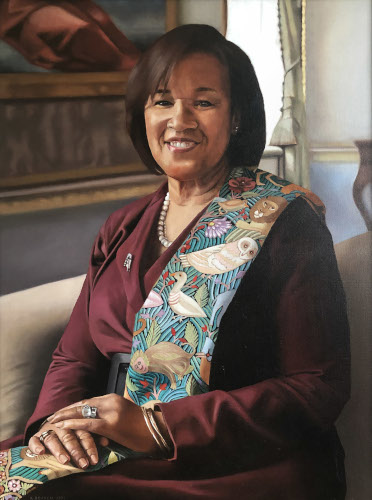
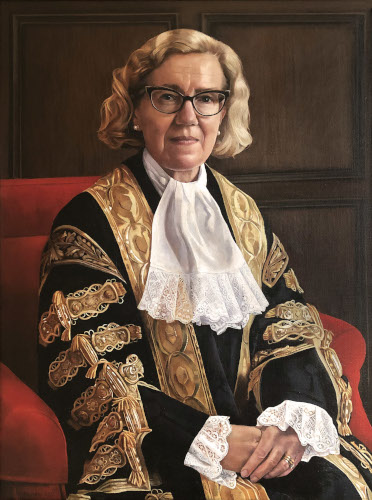
Master Scotland and Master Thirlwall by Alice Beaven.
Conclusion
While the representation of women, both as sitters and artists, within the Inn's painting collection remains less than that of men, it is growing, and as times progress, we will see a stronger female presence amongst the artwork, reflective of the contribution that women have made, both to art and to the Inn.